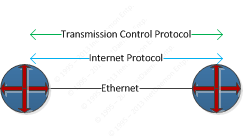
Studying for the CCNA or A+ certification exams? You must learn how TCP/IP works to pass your exam.
TCP/IP is not a single networking protocol but is a combination of Transmission Control Protocol (TCP) running on top of Internet Protocol (IP). Transmission Control Protocol (TCP) can be said to operate "on top of" Internet Protocol (IP). Internet Protocol (IP) provides functions such as addressing, communication and routing and carries Transmission Control Protocol (TCP) data. Transmission Control Protocol (TCP) provides the means to guarantee reliable delivery of computer data across a network using TCP/IP. Internet Protocol (IP) segments data from an application or program, is encapsulated inside an IP datagram and the IP datagram is then sent over a network connection. The TCP/IP suite of protocols is used together to transfer data reliably over the Internet.All of the following topics will appear on any CCNA or A+ exam, and in fact on any certification exam that requires knowledge of networking, including the CISSP and Security+ exams.
- Start with the OSI Model
- Internet Protocol
- What is Internet Protocol?
- Internet Protocol Addresses
- Classful Internet Protocol Addresses
- Classless Internet Protocol Addresses
- Internet Protocol Networks
- Network Address
- Broadcast Address
- Host Addresses
- Internet Protocol Subnetworks and Subnets
- Subnet Mask
- Variable Length Subnet Masks
- Classless Inter-Domain Routing
- Internet Protocol Hosts (IP Hosts)
- Unicast, Multicast and Broadcast Addresses
- Special IP Addresses
- Network Address
- Broadcast Address
- Multicast Addresses
- Private Addresses
- Internet Protocol Datagram/Packet Structure
- Internet Protocol Communication
- Internet Protocol Routing
- Routing Basics
- Routing Protocols
- Interior vs Exterior Routing Protocols
- Distance Vector Protocols
- Link State Routing Protocols
- Open Shortest Path First (OSPF)
- Intermediate System to Intermediate System (IS-IS)
- Enhanced Interior Gateway Routing protocol (EIGRP)
- Path Vector Routing Protocols
- Transmission Control Protocol Characteristics
- Data Transfer
- Reliability
- Flow Control
- Multiplexing
- Connection Oriented
- Precedence and Security
- Transmission Control Protocol Operation
- TCP Segmentation
- Establishing Connections
- Synchronization
- Acknowledgements
- 3-Way Handshake (SYN-SYN-ACK)
- Flow Control
- Sequence Numbers
- Sliding Window
- Reliable Data Transfer
- Connection Teardown
- TCP Reassembly
- Transmission Control Protocol Packet Structure
- TCP Header
- Payload
Bookmark this page and SHARE: